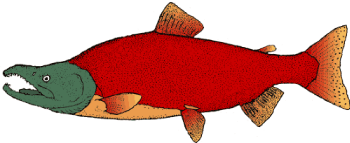 |
HomeSalmon Ecology 101
More than 20,000 species of bony fishes currently dominate earth’s waters; of those, 1% migrate between fresh and salt water1. Each summer, millions of Pacific salmon make incredible migrations from the North Pacific and Bering Sea back to freshwaters of their birth to spawn. Their embryos develop overwinter in rocky nests, called redds, and in spring emerge as “fry”. After a few months to a few years rearing in freshwater, depending on the species, young salmon migrate to sea. As they migrate they “imprint” or memorize a complex map of smells which helps them find their way back home2. Once they reach the food-rich sea, salmon grow quickly, increasing their weight over a hundred to a thousand times3. After 1 - 7 years feeding in the sea, salmon begin maturing and start their long migration home. They appear to use both the sun and the earth’s magnetic field to navigate through the vast ocean4.
Once they near freshwaters they rely on both their amazing sense of smell and the map of scents imprinted in their memory to navigate home to rivers and beaches of their birth where they spawn and then die. Returning salmon transport millions of tons of nutrients from the nutrient rich marine environment to the nutrient poor ecosystems of the Pacific Rim5, increasing production at all levels of the food chain, from bacteria and algae communities6 to top predators, such as bears.
Anadromous salmon are a “keystone” species in both aquatic and terrestrial environments, meaning they influence survival or reproduction of other species. More than 40 species of vertebrates, including salmon, trout, birds and mammals directly benefit from annual salmon runs by feasting on salmon, their eggs, carcasses, or their young12. Growth rates for juvenile salmon, trout and char all increase after the arrival and subsequent death of salmon13. Further, over 30% of the carbon and nitrogen in juvenile coho salmon have been traced to salmon derived nutrients14. Thus, even as carcasses, salmon help ensure overwinter survival of many freshwater fish by providing nutrients at summers end.
Scientists can usually tell what watershed a salmon is from by using genetic tools or biomarkers, like parasites or disease resistance. Even within a single watershed, populations of fish spawning in different habitats often show remarkable differences in many adaptive traits including spawn timing, size and age at maturity, and behavior, in addition to differences in their genetic makeup. This occurs for 4 main reasons: 1) salmon home precisely, thus little genetic interchange or gene flow occurs among populations; 2) environmental factors causing mortality (Natural Selection) vary among habitats, e.g., bears catch and eat more
fish in small shallow streams that in deep ones; 3) anadromous salmon only spawn once then die, if they get eaten by a bear prior to spawning their genes are out of the gene pool, and 4) most traits such as run timing are heritable- similar to you inheriting your mother’s nose or eyes! The fact that salmon spawning in different habitats of the same watershed show differences in important adaptive traits underscores the fact salmon populations are not necessarily interchangeable or replaceable. “Biodiversity”16 is a term used to describe all the variation observed among salmon populations and the high biodiversity observed among Alaskan salmon populations is considered an important factor in the long term sustainability of the fisheries16.
When a female salmon returns “home” to spawn, she chooses a site and prepares her redd (nest). She turns on her side and digs in the gravel using her strong tail, sweeping away fine sand and silt that could suffocate her eggs17,18. Large numbers of salmon spawning in a river help maintain spawning habitats by coarsening gravel through silt removal which in turn reduces gravel movement during floods19, both factors that can kill developing eggs. Annual cleaning of spawning areas is therefore an important task! Citations 1 Wooton, R. J. 1994. Ecology of Teleost Fishes. Chapman and Hall, NY, NY. 2 Wisby, W. J., and Hasler, A. D. 1954. Effect of olfactory occlusion on migrating silver salmon (Oncorhynchus kisutch). J. Fish. Res. Board Can. 11: 472–478. 3 Higgs, D. A., J. S. Macdonald, C. D. Levings and B. S. Dosanjh. 1995. Nutrition and feeding habits in relation to life history stage. Pages 159 – 315 in C. Groot, L. Margolis and W. C. Clarke, editors. Physiological Ecology of Pacific salmon. University of British Columbia Press. Vancouver. 4 Taylor, P. B. 1986. Experimental evidence for geomagnetic orientation in juvenile salmon, Oncorhynchus tschawytscha Walbaum. Journal of Fish Biology 28(5), 607–623.
5 Kline, T. C., J. J. Goering, and R. J. Piorkowski. 1997. The effect of salmon carcasses on Alaskan freshwaters. Pages 179–204 in A. M. Milner and M. W. Oswood, editors. Freshwaters of Alaska: ecological syntheses. Springer-Verlag, New York. 6 Wipfli, M. S., J. P. Hudson, and J. P. Caouette. 1998. Influence of salmon carcasses on stream productivity: Response of biofilm and benthic macroinvertebrates in southeastern Alaska, USA. Canadian Journal of Fisheries and Aquatic Sciences 55:1503–1511. 7 Stabell, O. B. 1987. Intraspecific pheromone discrimination and substrate marking by Atlantic salmon parr. Journal of Chemical Ecology. 7:1625-1643. 8 Groot, C., T. P. Quinn, and T. J. Hara. 1986. Responses of migrating adult sockeye salmon (Oncorhynchus nerka) to population specific odors. Canadian Journal of Zoology 64:926–932.
9 Alaska Department of Fish and Game, Commercial Fisheries Data. Anchorage, Alaska. 10 Gende, S. M., R. T. Edwards, M. F. Willson, and M. S. Wipfli. 2002. Pacific salmon in aquatic and terrestrial ecosystems. Bioscience. 10:917-928. 11 Hildebrand, G. V., C. C. Schwatz, C. T. Robbins, M. E. Jacoby, T. A. Hanley, S.M. Arthur, and C. Servheen. 1999. The importance of meat, particularly salmon, to body size, population productivity, and conservation of North American brown bears. Canadian Journal of Zoology. 77:132-138 12 Willson, M. F. and K. C. Halupka. 1995. Anadromous fish as keystone species in vertebrate communities. Conservation Biology. 3:489-497. 13 Wipfli, M. S., J. P. Hudson, J. P. Caouette, and D. T. Chaloner. 2003. Marine subsidies in freshwater ecosystems: Salmon carcasses increase the growth rates of stream-resident salmonids. Transactions of the American Fisheries Society 132:371–381, 2003. 14 Bilby, R. E., B. R. Fransen, P. A. Bisson, and J. K. Walter. 1998. Response of juvenile coho salmon (Oncorhynchus kisutch) and steelhead (Oncorhynchus mykiss) to the addition of salmon carcasses to two streams in southwestern Washington, USA. Canadian Journal of Fisheries and Aquatic Sciences 55:1909–1918. 15 Bilby R. E., B. R. Fransen and P. A. Bisson Incorporation of nitrogen and carbon from spawning coho salmon into the trophic system of small streams: Evidence from stable isotopes. Can J Fish Aquat Sci 1996, 53:164-173
16 Hilborn et al. Biocomplexity and fisheries sustainability. PNAS. 2003,11:6564-6568.
17 Chapman, D. W. 1988. Critical review of variables used to define effects of fines in redds of large salmonids. Transactions of the American Fisheries Society. 117:1-21. 18 Kondolf, G. M., M. J. Sale, M. G. Wolman. 1993. Modification of fluvial gravel size by spawning salmonids. Water Resources Research. 7:2265-2274. 19 Montgomery, D. R., J. M. Buffington, N. P. Peterson, D. Schuetthames, T. P. Quinn. 1996. Stream-bed scour, egg burial depths, and the influence of salmonid spawning on bed surface mobility and embryo survival. Canadian Journal of Fisheries and Aquatic Sciences 5:1061-1070. Salmon Ecology 101 Fact Sheet (pdf file 303 kb)
|
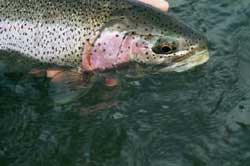
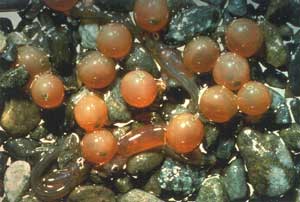
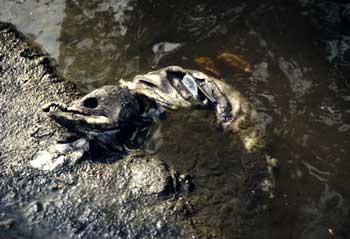
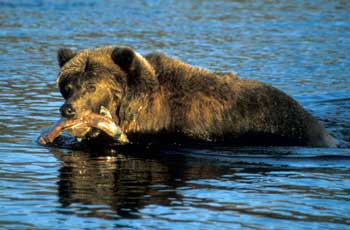

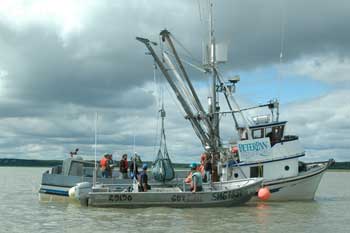 More than 1.7 billion salmon have been harvested from Bristol Bay since the fishery began in 1893; over 1.6 billion or 94% of those salmon were sockeye. Not only is is the world’s largest sockeye salmon fishery, but is one of the few fisheries of the world that is recognized as sustainable. The larger run of fish harvested annually is actually comprised of hundreds of smaller unique breeding populations that are adapted to their home or natal streams. The differences among all the smaller populations is termed biodiversity. This biodiversity helps sustain the fishery as fish production varies due to climate variation. Some salmon populations produce more fish under warmer climates while others produce more during cooler climates16.
More than 1.7 billion salmon have been harvested from Bristol Bay since the fishery began in 1893; over 1.6 billion or 94% of those salmon were sockeye. Not only is is the world’s largest sockeye salmon fishery, but is one of the few fisheries of the world that is recognized as sustainable. The larger run of fish harvested annually is actually comprised of hundreds of smaller unique breeding populations that are adapted to their home or natal streams. The differences among all the smaller populations is termed biodiversity. This biodiversity helps sustain the fishery as fish production varies due to climate variation. Some salmon populations produce more fish under warmer climates while others produce more during cooler climates16.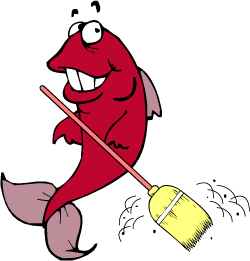 Salmon Clean House?
Salmon Clean House?